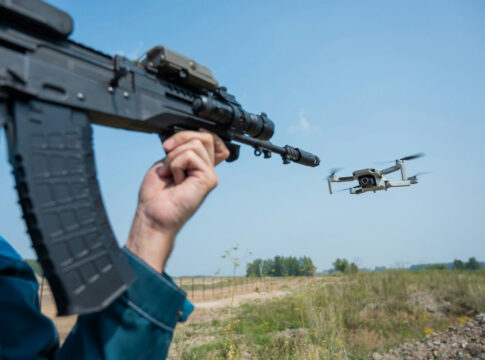America’s skies are a national security free-for-all, and our leaders have left the back door wide open for anyone with a drone and bad intentions to walk right in—are we really supposed to believe this is how a superpower protects itself?
America’s Drone Problem: A Clear and Present Danger to National Security
America’s enemies used to need a plane, a passport, or at least a sense of subtlety to threaten our homeland. Now, all they need is a drone and a little Wi-Fi. That’s not an exaggeration—it’s the blunt truth coming from experts who testified before Congress this year. The headlines tell a grim story: near-collisions between drones and commercial jets at major U.S. airports, drones grounding rescue helicopters during disasters, and criminal cartels using off-the-shelf quadcopters to smuggle drugs and weapons at the border. The FAA logged a 26% surge in drone incursions into restricted airspace in just the first quarter of this year. Yet, the federal government’s approach to airspace security looks like it was designed in 1995 and never updated.
America's skies are wide open to national security threats, drone expert warns: 'We have no awareness' https://t.co/WYZzKhBEM6
— Alicia Acuna (@aacuna1) July 28, 2025
With the Biden administration now a bad memory, you’d think the days of “see no evil, hear no evil” would be over. But here we are, still stuck with a patchwork of altitude limits, no-fly zones, and a so-called “Remote ID” system that’s about as useful as a screen door on a submarine. No centralized, real-time tracking. No digital license plates. No way for law enforcement to know who’s flying what, let alone why. All while the number of small drones is projected to hit a staggering 2.4 million by year’s end, outnumbering even the most basic security measures in place.
Regulatory Chaos and Congressional Gridlock
Congress has finally started to notice, holding urgent hearings and grilling drone industry leaders about the national security disaster unfolding in our skies. Tom Walker, CEO of DroneUp, didn’t mince words: “We don’t have awareness of our airspace… We can’t look at a picture, and see all of the drones and manned aircraft and say, ‘Here’s who this is and here’s what they’re doing.’” The Department of Homeland Security’s counter-UAS director warned that cartels are already using drones for smuggling and that kinetic attacks on Americans are no longer a hypothetical—they’re a looming reality. And still, the bureaucracy lumbers along, debating whether to prioritize “counter-UAS” jammers and interceptors or finally get serious about proactive drone identification and airspace integration.
There is a real and significant threat of drone attacks in the U.S., with experts warning of attacks on critical infrastructure, including chemical warfare, according to witnesses appearing before a House committee Tuesday afternoon.https://t.co/v1M5UiXU0a
— ABC 7 Amarillo (@ABC7Amarillo) July 16, 2025
Meanwhile, bipartisan bills to expand military and law enforcement authority to take down rogue drones are stuck in committee. Industry lobbyists cry about regulatory overreach, while first responders beg for basic tools to neutralize drones during emergencies. It’s a rerun of every government failure we’ve seen before: endless studies, pilot programs, and “stakeholder engagement” while the threats multiply and the public’s patience runs thin.
Catastrophe Looms as Drones Outpace Law and Order
The real-world consequences are plain as day. Airline passengers and crews are put at risk every time a drone buzzes a jet on approach. Firefighters watch helplessly as their aircraft are grounded by unauthorized drones during wildfires and floods. Border agents battle criminal organizations who now have aerial eyes and delivery systems that law enforcement can barely track, let alone stop. Academic research, including studies from Embry-Riddle Aeronautical University, confirms that most near-misses happen within 1.5 miles of airports during the riskiest phases of flight. Every expert worth their salt says the same thing: it’s not a matter of if, but when, a drone disaster will make headlines for all the wrong reasons.
Yet instead of decisive action, we get more of the same: fragmented regulations, overwhelmed agencies, and a drone industry more interested in market share than airspace safety or national security. The FAA’s half-baked Remote ID system exists on paper but fails in reality, easily circumvented by anyone with the technical know-how of a teenager. And as the number of drones in our skies explodes, public confidence in both the technology and the government’s ability to manage it is eroding by the day.
Time to Put America First—In the Skies and on the Ground
Let’s be clear: No responsible nation leaves its airspace wide open to anonymous, untrackable flying machines while hoping nothing bad happens. The United States has always been a beacon of innovation, but not at the expense of safety, security, or common sense. The time for talk is over. Congress needs to deliver enforceable, real-time tracking and identification for every drone, everywhere. Law enforcement and first responders deserve the authority and the tools to protect our skies and our communities. And the federal government must finally treat this as the national security emergency it is—not another item to be studied, debated, and kicked down the runway.
The lack of drone countermeasures by public safety agencies.
Hard conversations about drones equipped with explosives represent a significant threat to public safety for several reasons:
Drones are widely available and relatively affordable, making them accessible not only to… pic.twitter.com/RrkiCQ2Jjf
— Bill Partridge 🇺🇸 (@ChiefBPartridge) July 28, 2025
Until that happens, America’s enemies—foreign and domestic—will keep exploiting the gaping holes in our defenses. And the American people, as always, will be left to wonder why the most powerful country in the world can’t—or won’t—protect its own backyard.
Sources:
Embry-Riddle Aeronautical University

